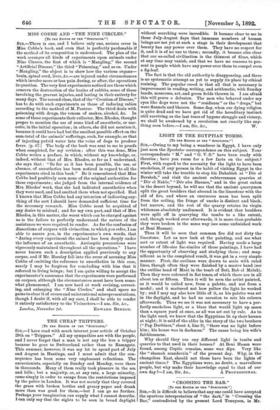LIGHT IN THE EGYPTIAN TOMBS.
[To THE EDITOR OF THE " SPECTATOR."] SIR, Owing to my being a wanderer in Egypt, I have only just seen the Spectator correspondence on this subject. Your correspondents " M." and " G. V. S." have been ready with theories ; have you room for a few facts on the subject
First, with regard to the necessity for the light to have been smokeless, if any person in the habit of visiting Egypt in the- winter will take the trouble to stop his Dahabieh at " Der el Bersheh," and visit the ancient subterranean quarries at "Der el Nakle," "Der abu Haunes," and in the great canon in the desert beyond, he will see that the ancient quarrymen split the great boulders that abound in the limestone with the- aid of fire, and where an enormous mass has been split from the ceiling, the fringe of smoke is distinct and black,.
but narrow, and the rest of the quarry retains its virgin whiteness absolutely undimmed. It is evident that boulders were split off in quarrying the tombs to a like extent, and, though worked over afterwards, it is more than probable they were broken in the same way (see some unfinished work at Beni Hassan).
Thus it will be seen that common fire did not dirty the limestone. Let us now look at the painting, and see what sort or extent of light was required. Having made a large number of life-size fac-similes of these paintings, I have had the opportunity of observing and studying them ; and mag- nificent as is the completed result, it was got in a very simple- manner. First, the outlines were drawn to scale with ruled lines, though often they were finished by a master hand (see the outline head of Mait in the tomb of Seti, Bab el Meluk). Then they were coloured in flat tones, of which there are in all about ten or fifteen. Thus it will be seen the artist painted, as it would be called now, from a palette, and not from a model ; and it mattered not how yellow the light he worked by; and I may say also how little of it, as his palette was set in the daylight, and he had no occasion to mix his colours- afterwards. Thus we see it was not necessary to have a per- fectly smokeless light, or a blaze that would light up more
than a square yard at once, as all was set out by rule. As to, the light used, we know that the Egyptians lit up their houses.
at night; it is said of the elder in the story of the two brothers. (" Pap Dorbines," sheet 4, line 9), "there was no light before him; his house was in darkness." The cause being his wife's. faithlessness.
Why should they use any different light in tombs and quarries to that used in their houses P At Beni Hasan were found, among Coptic remains, some wax dips. Very like the " shamah scanderiin " of the present day. Why, in the changeless East, should not these have been the lights of ancient times P The Egyptians were, no doubt, a marvellous. people, but why make their knowledge equal to that of our






















































 Previous page
Previous page